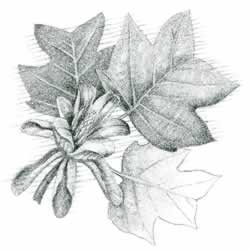 Caldwell
Fields
Caldwell
Fields [Fig. 20(16)] Pandapas Pond is a pleasant little 8-acre lake, easy to reach off US 460. In addition to a measure of solitude, it offers fishing, a walking trail around the lake, and picnicking, and it is well suited for a morning of leisurely, flat-water canoeing. Pandapas is in the headwaters of Poverty Creek [Fig. 20(15)] in northwest Montgomery County, just minutes west of Blacksburg. An easy 1-mile loop trail at an elevation of 2,200 feet skirts the pond's edge. At the northeast end is a wetland environment. Surrounding the pond are Appalachian hardwoods and pines.
A butternut tree (Juglans cinerea)—sometimes called white walnut—grows about midway between US 460 and Poverty Creek on the northwest side of the pond. The wood of this tree is much lighter brown than its cousin, the black walnut. The greenish nut has a sticky surface and is oval rather than round, as the black walnut is. In the colorful understory in spring are redbud, flame azalea, pinkster, Catawba rhododendron, and mountain laurel.
Where the lake trail crosses a little bridge at the lower end of the pond, the brilliant red spires of cardinal flower (Lobelia cardinalis) grow. Somewhere back in the woods, a yellow-billed cuckoo (Coccyzus americanus) calls. (Like ovenbirds, they're never in sight.) Because the cuckoo is inclined to sound off when a storm is approaching, mountain people call the bird a "rain crow."
District naturalists know which of the wildflowers at Pandapas Pond are in bloom. Colonies of rare fringed polygala (Polygala paucifolia)—also known as gaywings and bird-on-the-wing—find conditions perfect in the moist woodlands. This tiny purplish flower grows only 2 to 6 inches tall. Depending on the time of year, visitors can also find fire pinks (Silene virginica), several varieties of bird's-foot violet (Viola pedata), liverwort (hepatica), wandflower (Galax), and yellow lady slipper (Cypripedium calceolus).
Due to environmental concerns, the area around the parking lot and Pandapas Pond are off-limits to bikers, equestrians, and campers. Foot travel is welcome. Primitive camping is allowed along Poverty Creek below the lake on national forest land, and there are fire rings alongside the creek. An annual children's fishing day attracts families to the Blacksburg Ranger District in early May. Call for exact dates.
[Fig. 20(15)] Below Pandapas Pond, Poverty Creek threads its way southwest through the mountain pass to the New River. On the other side of US 460, Craig Creek takes off for the James River. Both streams are stocked by the state with feisty rainbow, brook, and brown trout from an area hatchery. In summer, the water level in the two streams gets low, and stocking is suspended until the creeks refill. Trout fishing is best in late fall, winter, and early to late spring.
On these streams, morning fog hangs in the treetops like a gossamer canopy. Even in summer, an occasional leftover trout and several minnows flash in the gin-clear water. Outside the cool dimness created by overarching hemlocks, fish dart for cover beneath undercut banks.
Poverty Creek below the pond leads to an old logging road, and along the path are beaver cuttings where the secretive animals have dammed the stream to form more wetlands. Wildflowers and moisture-loving plants thrive here. Off the trail a bit, many varieties of mushrooms spring from decaying organic matter.
[Fig. 20(18)] An 18-position rifle and pistol range and a single-position trap shooting range are available for the public just 3 miles west of Blacksburg. The rifle/pistol range is designed for firing at a stationary target at 25, 50, and 100 yards and at 100 meters. Clay pigeons may be used on the trap range.
 Caldwell
Fields
Caldwell
Fields [Fig. 20(17)] A campground consisting of three fields on Craig Creek is available for groups year-round. Rates vary from $25 to $50, depending on group size. Reservations are required. The largest field is set aside for day use only. Having been left in a more or less natural state, it is a good place to study wildflowers or watch wildlife, especially early and late in the day.
The other two smaller fields can be rented for overnight events. They have been cleared and landscaped, and have group fire rings.
Read and add comments about this page